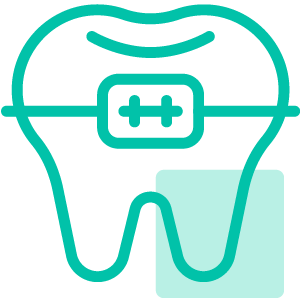Metal
- Home
- Orthodontic Introduction
- Metal
Traditional metal braces consist of metal brackets and archwires and are popular with young children and some teenagers.

Traditional metal braces consist of metal brackets and archwires. These brackets are glued to the front of your teeth. The wire is shaped into the ideal position of your teeth and then threaded through the brackets. As the wires struggle to get back to their original shape, they gradually pressure your teeth into that shape as well. We then tighten the wires every four to six weeks. You should see a nice, straight smile within two or two and a half years (although this time period can be shorter or longer, depending on the severity of your problem). Once your braces come off, you will likely wear a retainer for six months to a year to keep your teeth from shifting and your new smile in place.
In the past metal braces were not just brackets, but bands that wrapped around the entire tooth. Nowadays, people wear small metal brackets that are glued to the front of each tooth. The former ones are usually reserved for molars or teeth with fillings that spill to the outside surface of a tooth.
Metal brackets tend to be less expensive than other types of brackets. In addition, you can make them colorful with ligatures that come in a rainbow of colors.
Advantages of Metal Braces
- Metal brackets tend to be the least expensive of all the types of braces.
- They tend to take the least amount of time among all the types of braces.
- You can choose a darker ligature, which will not show curry, smoking, or black coffee stains.
- Self-ligating brackets do not contain rubber ligatures, so staining will never be a problem.
- They are strong and rarely break.
- The golden brackets are different, novel, and generally look nice.

Disadvantages of Metal Braces
- They are more visible than ceramic and Invisalign.
- They tend to be a bit less comfortable at first, but that feeling wears off after a couple of weeks.
- When you have a canker sore, they tend to irritate your gums more than ceramic brackets.
Book an Appointment for Consultation.
View Our Gallery

Before and After Treatment Results by Latest Technology
Dental hygiene is the practice of keeping the mouth and teeth clean to prevent dental problems, like cavities, gingivitis, and bad breath. Good oral hygiene is required for healing and regeneration of the oral tissues following a dental procedure.

Before and After Treatment Results by Latest Technology
Dental implants are designed to replace one or more teeth. The implants are made of titanium, biocompatible material that is not rejected by the body. The implants hold up the natural bone, stabilising the jaw bone levels and minimise further bone loss. The implants are placed through a quick and minimally invasive procedure.

Before and After Treatment Results by Latest Technology
Periodontology focuses on prevention, diagnosis and treatment of diseases of the supporting and investing structures of the teeth including the gums, cementum, periodontal membranes, and alveolar bone. Diseases affecting the rest of the body, known as systemic diseases, can weaken the supporting structures of the teeth.

Before and After Treatment Results by Latest Technology
Cosmetic dentistry addresses aesthetic issues that can make you feel selfconscious like stained, chipped and gapped teeth. Cosmetic dental treatments can improve the colour, position, shape, size, alignment and overall smile appearance.

Before and After Treatment Results by Latest Technology
Orthodontics corrects teeth and jaw alignment problems using devices such as braces, special fixed and removable appliances, fixed and removable space maintainers, and invisible aligners. If you have crowded teeth, spacing, an underbite, overbite, crossbite, openbite, or a misplaced midline, orthodontics could be for you.

Before and After Treatment Results by Latest Technology
A denture is a removable appliance which is worn to replace lost or missing teeth. Two types of dentures are available, complete and partial dentures. Complete dentures are used when all the teeth are missing, while partial dentures are used when some natural teeth remain.

Before and After Treatment Results by Latest Technology
Your dentist can suggest various treatments to prevent potential problems and to restore damaged teeth. These treatments help restore the appearance, shape and function of your teeth, and can help prevent the build up of plaque acids on the enamel surface of teeth and are of value in the prevention of tooth decay.

Before and After Treatment Results by Latest Technology
At Star Smiles we offer many dental procedures including gum lifts, tooth extractions, and other surgical procedures. We offer the latest laser dentistry that eliminates the need for stitches, minimises bleeding, and sterilises the area on-the-go to minimise the risk of infection.
